

Typical
event in the HERAB detector at a target interaction rate of 40 MHz.
In average about 120 charged tracks will be visible in the
detector
every 100 ns. The innner tracker covers the area near the beam pipe where
the particle density is highest.
It
should be noted that high energy physics experiment did so far not
have such severe requirements for tracking and there had been no field
proven technology .
The
solution to the problem chosen for the experiment HERAB is the 'micro strip
gaseous chamber' ( MSGC) which was invented by Oed 10 years ago. The
principle of the MSGC is shown below: The readout structure consists of
a microelectrode structure of anodes and cathodes which are lithographically
put to a substrate. The anodes in our case have a width of 10 microns
, the cathodes a width of 170 microns separated by a 60 micron gap. The
pitch of anodes is therefore 300 microns. The electrodes are made of gold
500 nm thick. Above the electrodes is the chamber gas volume, 3 mm high
which is closed by the drift cover. The MSGC works like a multiwire
proportional chamber with gas amplification. The anodes are put to ground,
a drift field is applied between cover and anodes of typically 4 kV/cm.
The gas gain at the anodes is mostly dependent on the cathode voltage.
For a typical voltage of 650 V the gas gain is about 4000 and it depends
exponentially on the cathode voltage. Counting gases used are Ar:DME
50:50 or Ar:CO2 70:30. A minimum jonising particle frees about
30 electrons in the 3 mm drift gap. These drift to the anodes and are amplified
there . In average the signal of one particle is seen on 1.6 anodes (strip
multiplicity).
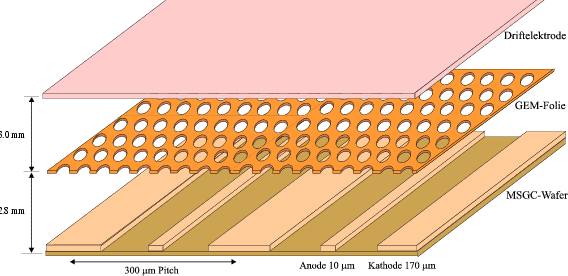
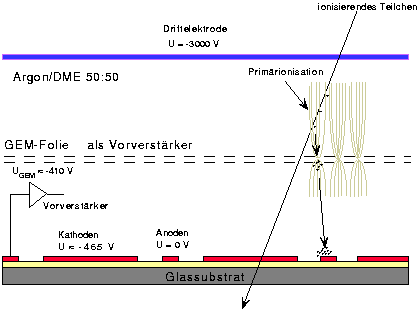
3D view of an MSGC/GEM detector
cross section through an MSGC/GEM detector
It
had been shown already by Oed, that such a detector can tolerate very high
particle rates (up to 1 million particles per square mm and second.). What
was unclear however if these detectors can survive several years of operation
under high particle fluxes. Gaseous detectors have always the problem of
'gas ageing' e.g. they have a tendency to deposit polymer layers on the
anodes which are formed in the plasma from organic substances e.g. impurities
in the gas. The detectors also work very near to the discharge limit and
are therefore vulnerable to gas discharges which could destroy the
thin electrodes.
Extensive tests of MSGC detectors have been done in the institute over
the last 5 years. The results are documented in detail in a series of diploma
theses and theses ( publications
on MSGC's ). We have done extensive ageing tests with X-ray irradiation
and we have performed several beam tests in intense hadron beams both at
PSI with pion and proton beams and within HERAB at HERA. Here is
a summary of the main results:
1) the substrates need a well defined electronic conductivity. We use glass
substrates which are coated by a 'diamond' layer with a conductivity
of about 10**14 Ohms per
square
(coated wafers).
2) MSGC's with coated wafers and carefully selected gases and materials
are able to survive several years of intense X-ray radiation. If they are
exposed to intense hadron beams however they show frequent gas discharges
at gains above about 1500. These gas discharges are induced by heavily
ionising particles -- most likely spallation products - which deposit a
very large charge in the neighbourhood of the anodes. Gas discharges damage
the electrodes and can therefore not be tolerated. Our studies showed that
the spark rate depends to very good approximation only on the cathode
voltage. A reduction of cathode voltage below the onset of discharges results
in too low gas gain however.
3) The solution to this problem is to do the gas amplification in two stages
by the introduction of a second gas amplification device , the ' gas electron
multiplier' (GEM). This is a capton foil, 70 micron thick covered with
Cu on both sides. A large number of small holes is etched into this foil
-- e.g. holes with 60 micron diameter and a distance of 140 micron
between the holes. A photograhy of a GEM is shown below.
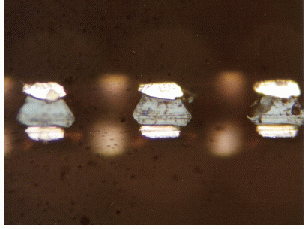
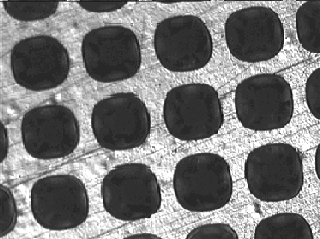
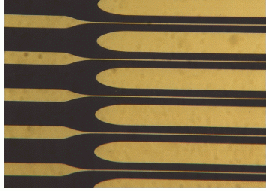
Cut
through a GEM foil under microscope
GEM foil seen from top under microscope
gold electrode structure. Left: anode bondpads.
Visible
are 2 holes 60 micron wide.
Distance between holes is 140 microns.
Anode width 10 microns, cathodes 140 microns.
If a voltage
of about 400 V is applied across the GEM then all electrons passing through
the holes are multiplied by a factor of about 25. A GEM foil combined with
a MSGC allows then to limit the gas gain of the MSGC to about 200 which
is reached by cathode voltages below the
set on
of gas discharges.
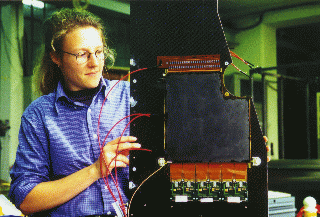 Fully assembled MSGC/GEM with readout electronics
Fully assembled MSGC/GEM with readout electronics
MSGC/GEM
detectors are presently constructed and installed in the HERAB experiment.
The Inner Tracker will consist of 46 detector layers, each
layer being composed of four rectangular MSGC's of about 30 x 30 cm2 outer
dimensions. With an electrode pitch of 300 micron a total number of 140
000 channels has to be read out.
This readout
is performed by a highly integrated readout chip specially developed by
the Heidelberg ASIC laboratory in collaboration with a group from the MPI.
This chip
Helix
128 makes an analog readout of 128
strips with a sampling rate of 10 MHz and stores the information in a pipeline
for 12 microseconds.
The detector should be ready for operation by the end of 1999.
[1] Th. Lohse et al., An Experiment to study CP Violation in the B System Using an Internal Target at the HERA Proton Ring, Proposal, DESY-PRC 94/02 (1994)